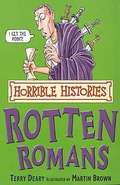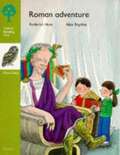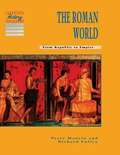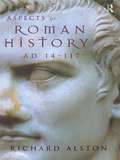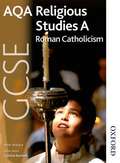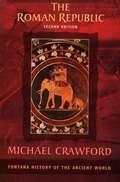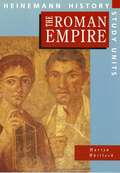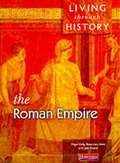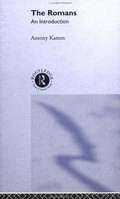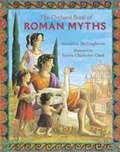Special Collections
Romans (rotten or not!)
Description: Images and books to support project and theme based learning on Roman history.
- Table View
- List View
Horrible Histories
by Terry Deary and Martin BrownGo back into the really rotten times of the Romans, where there were beastly battles, deadly doctors and marvellous myths. Discover what Roman soldiers wore under their kilts, how ancient Britons got their hair nice and spikey and why rich Romans needed a vomitorium. History with the nasty bits left in! 2013 is HORRIBLE HISTORIES twentieth anniversary.
Oxford Reading Tree, Stage 7, More Owls
by Roderick HuntThe children go to Ancient Rome and learn about chariots and introduce the Roman's to pizza.
Oxford Reading Tree, Stage 7, More Owls
by Roderick HuntThe children go to Ancient Rome and learn about chariots and introduce the Roman's to pizza.
Plan of a Roman Bath House (large print)
by RnibThe image shows a plan of a typical Roman Bath House. There is a locator dot shown, which will be at the top left when the image is the correct way up. The entrance to the Bath House (aditus) is in the bottom right of the page. It is a small area with a door to the changing room (apodyterium) on the left. To the top right of the changing room is a door to a small storeroom. This is where the aromatic oils used in the bath house would be kept. To the top left of the changing room is a door to a small lobby area (vestibule) which is an entrance way into the baths from the changing rooms. Left from here is the cool room (frigidarium) with a cold pool. Up from the cool room is the warm room (tepidarium). There is a tepid pool here. To the right of this is a hot but normally dry room (laconicum). Up from the warm room is another hot room (caldarium), this time with a hot pool. This room usually has a cold fountain (labrum) as well. The water from the fountain is used to splash on the face for refreshment. Right from here is another hot room (alveus) with really hot baths. Not all bath houses have this type of room. Right from here is the furnace room (Praefurnium). This is where the fires to heat the rooms and baths are. There is a door into the room from the outside in the top left of the room. Notice that the nearer a room is to the furnace room the hotter it and its water is. Hot air is circulated under the floor and into wall cavities via channels (hypocausts), so the nearer a room is to the furnace the hotter this air will be. Only the three hot rooms have hot air wall spaces.
Plan of a Roman Bath House (UEB uncontracted)
by RnibThe image shows a plan of a typical Roman Bath House. There is a locator dot shown, which will be at the top left when the image is the correct way up. The entrance to the Bath House (aditus) is in the bottom right of the page. It is a small area with a door to the changing room (apodyterium) on the left. To the top right of the changing room is a door to a small storeroom. This is where the aromatic oils used in the bath house would be kept. To the top left of the changing room is a door to a small lobby area (vestibule) which is an entrance way into the baths from the changing rooms. Left from here is the cool room (frigidarium) with a cold pool. Up from the cool room is the warm room (tepidarium). There is a tepid pool here. To the right of this is a hot but normally dry room (laconicum). Up from the warm room is another hot room (caldarium), this time with a hot pool. This room usually has a cold fountain (labrum) as well. The water from the fountain is used to splash on the face for refreshment. Right from here is another hot room (alveus) with really hot baths. Not all bath houses have this type of room. Right from here is the furnace room (Praefurnium). This is where the fires to heat the rooms and baths are. There is a door into the room from the outside in the top left of the room. Notice that the nearer a room is to the furnace room the hotter it and its water is. Hot air is circulated under the floor and into wall cavities via channels (hypocausts), so the nearer a room is to the furnace the hotter this air will be. Only the three hot rooms have hot air wall spaces.
Map of the Roman Empire, circa 150AD (UEB contracted)
by RnibThis map shows the extent of the Roman Empire at this time. It is surrounded by an image border, and the countries have been marked by abbreviated letters. These can be referenced in the key that runs along the bottom of the page. There is a locator dot shown, which will be at the top left of the page when the image is the right way up. In the top right corner of the page there is a north arrow. Within the image border the un-textured areas represent the sea. The Roman Empire dominates countries around the centre of the map and surrounds the Mediterranean Sea. The Roman Empire itself was surrounded by other lands, which include Europe across the top section of the image and North Africa along the bottom section.
The Roman World
by Peter Mantin and Richard Pulley and Tony McaleavyThe Roman World is an investigative course designed to develop students' historical knowledge, skills and understanding of ancient Rome. It is divided into units that present different aspects of the Roman world and pose key historical questions. The unit topics include the rise of the Roman republic, family life, gods and goddesses, Roman Britain, and the decline and fall of the empire. Each unit carefully balances explanation and investigation while overview and review sections introduce and consolidate key themes and concepts. The book's content is drawn from a wide range of primary sources, explanatory diagrams and maps. The Roman World is an excellent introduction and is suitable for use in ancient history or Latin courses. An accompanying Teacher's Resource Book includes teaching objectives, practical ideas for each unit, and photocopiable resource sheets with lively classroom activities.
Aspects Of Roman History, A. D. 14-117
by Richard AlstonAspects of Roman History AD14 117 charts the history of the Roman Imperial period, from the establishment of the Augustan principate to the reign of Trajan, providing a basic chronological framework of the main events and introductory outlines of the major issues of the period. The first half of the book outlines the linear development of the Roman Empire, emperor by emperor, accenting the military and political events. The second half of the book concentrates on important themes which apply to the period as a whole, such as the religious, economic and social functioning of the Roman Empire. It includes: a discussion of the primary sources of Roman Imperial history clearly laid out chapters on different themes of the Roman Empire such as patronage, religion, the role of the senate, the army and the position of women and slaves designed for easy cross-referencing with the chronological outline of events maps and illustrations a guide to further reading. Richard Alston's highly accessible book is designed specifically for students with little previous experience of studying ancient/Roman history. Aspects of Roman History provides an invaluable introduction to Roman Imperial history, which will allow students to gain an overview of the period and will be an indispensable aid to note-taking, essay preparation and examination revision. "
Aspects Of Roman History, A. D. 14-117 (PDF)
by Richard AlstonAspects of Roman History AD14 117 charts the history of the Roman Imperial period, from the establishment of the Augustan principate to the reign of Trajan, providing a basic chronological framework of the main events and introductory outlines of the major issues of the period. The first half of the book outlines the linear development of the Roman Empire, emperor by emperor, accenting the military and political events. The second half of the book concentrates on important themes which apply to the period as a whole, such as the religious, economic and social functioning of the Roman Empire. It includes: a discussion of the primary sources of Roman Imperial history clearly laid out chapters on different themes of the Roman Empire such as patronage, religion, the role of the senate, the army and the position of women and slaves designed for easy cross-referencing with the chronological outline of events maps and illustrations a guide to further reading. Richard Alston's highly accessible book is designed specifically for students with little previous experience of studying ancient/Roman history. Aspects of Roman History provides an invaluable introduction to Roman Imperial history, which will allow students to gain an overview of the period and will be an indispensable aid to note-taking, essay preparation and examination revision. "
AQA GCSE Religious Studies A
by Peter John Wallace and Cynthia BartlettWritten for the AQA GCSE Religious Studies A specification, the student book provides a focused look on individual religions. Key terms reinforce learning, providing definitions of key words that students need to be familiar with.
The Roman Republic (Fontana History of the Ancient World) (PDF)
by Michael CrawfordBetween the Sack of Rome by the Gauls in 390 BC and the middle of the second century BC, a part-time army of Roman peasants, under the leadership of the ruling oligarchy, conquered first Italy and then the whole of the Mediterranean. The loyalty of these marrauding heroes, and of the Roman population as a whole, to their leaders was assured by a share in the rewards of victory, rewards which became steadily less accessible as the empire expanded - promoting a decline in loyalty of cataclysmic proportions.Wars, rural impoverishments, civil discord and slavery are a few of the subjects covered in this study.
Heinemann History Study Units
by Martyn WhittockFocusing on the Roman Empire, this is one of a history series which offers teachers the flexibility to design their own scheme of work at Key Stage 3 of the National Curriculum.
Living Through History
by Rosemary Rees and Jane Shuter and Nigel KellyLiving Through History is a complete Key Stage 3 course which brings out the exciting events in history. The course is available in two different editions, Core and Foundation. Every core title in the series has a parallel Foundation edition. Each Evaluation Pack includes the Assessment and Resource Pack and a free compendium volume student book. The resource packs include a variety of tasks which students should find interesting and enjoyable. They also include differentiated exercises to provide support for less able students and challenging work for more able students. Assessment exercises for the compulsory study units aim to help teachers monitor progress through NC levels.
Roman mosaic
by Rnib BookshareThis image shows a diagram of a mosaic and a diagram of a detail of the mosaic. There is a locator dot shown, which will be at the top left of the page when the image is the correct way up. There is the complete but simplified mosaic on the left of the page and a detail showing the tiles that make up part of the mosaic on the right of the page. A traditional Roman mosaic is made of a great number of differently coloured tile fragments. In the image on the right the tiles are shown significantly larger than in real life so it will work tactually. The diagram on the left shows an image of a duck seen from the side facing left, both legs can be found but only one eye and wing is shown. It is surrounded by decorative fronds and vine leaves. The ducks head is towards the top left of the image with the beak pointing left and down. From the head the neck curves down and left to the body. At the base of the neck there is a part ring of white. In the centre of the body a bolder line that curves down and right represents the wing. Towards the tail on the right there is a patch of paler colour. Down from the body are the two legs and wide feet. On the left of the image is an area representing leaves. From them come curling tendrils in two shades of green - dashed and solid lines. To the right of the ducks head is a circular flower head. It has various rings of colour getting smaller to the centre. A wiggly stem goes down and right to the edge of the image. Halfway along it has a leaf up and down from the stem. At the bottom right are more vine leaves and one decorative frond. A line of very dark green tiles surrounds the image. At the top and bottom these are two tiles wide. An image border surrounds the image on the right. Most of the image is the duck enlarged from the image on the left. The duck fills the centre of the image and is shown in tiles, mainly a green colour. The ducks head is in the top left of the image with the beak pointing left and down. The beak is made from red-brown tiles. In the centre of the head is an eye made from a single dark blue tile. It is surrounded by white tiles. From the head the neck curves down and left to the body. At the base of the neck there is a part ring of white fringed with very dark blue tiles above and below it. In the centre of the body a bolder line of tiles that curves down and right represents the wing. At the start of this line up and down the page are pale yellow-green tiles. Towards the tail on the right there is a patch of paler coloured tiles. The breast of the bird is in red-brown tiles. Down from the body are the two legs and wide feet. The one to the left is of green tiles but the one to the right is of red-brown tiles. In the top right of the image is the flower head. In the centre is a dark brown tile surrounded by four white tiles. Pale yellow green tiles surround this. The outer edge of the flower head is a ring of alternating red-brown and white tiles. A line of dark green tiles goes from the bottom right of the flower head to the centre right of the image, these represent the flower stem. Dark green tiles up and down from this represent parts of leaves. The background to the image, surrounding the duck and flower, is a mass of small ivory coloured tiles. For clarity these are not shown. The mosaic dates from the 3rd to 5th century. It was found in Tunis, Tunisia. The artist is unknown.
Roman mosaic
by Rnib BookshareThis image shows a diagram of a mosaic and a diagram of a detail of the mosaic. There is a locator dot shown, which will be at the top left of the page when the image is the correct way up. There is the complete but simplified mosaic on the left of the page and a detail showing the tiles that make up part of the mosaic on the right of the page. A traditional Roman mosaic is made of a great number of differently coloured tile fragments. In the image on the right the tiles are shown significantly larger than in real life so it will work tactually. The diagram on the left shows an image of a duck seen from the side facing left, both legs can be found but only one eye and wing is shown. It is surrounded by decorative fronds and vine leaves. The ducks head is towards the top left of the image with the beak pointing left and down. From the head the neck curves down and left to the body. At the base of the neck there is a part ring of white. In the centre of the body a bolder line that curves down and right represents the wing. Towards the tail on the right there is a patch of paler colour. Down from the body are the two legs and wide feet. On the left of the image is an area representing leaves. From them come curling tendrils in two shades of green - dashed and solid lines. To the right of the ducks head is a circular flower head. It has various rings of colour getting smaller to the centre. A wiggly stem goes down and right to the edge of the image. Halfway along it has a leaf up and down from the stem. At the bottom right are more vine leaves and one decorative frond. A line of very dark green tiles surrounds the image. At the top and bottom these are two tiles wide. An image border surrounds the image on the right. Most of the image is the duck enlarged from the image on the left. The duck fills the centre of the image and is shown in tiles, mainly a green colour. The ducks head is in the top left of the image with the beak pointing left and down. The beak is made from red-brown tiles. In the centre of the head is an eye made from a single dark blue tile. It is surrounded by white tiles. From the head the neck curves down and left to the body. At the base of the neck there is a part ring of white fringed with very dark blue tiles above and below it. In the centre of the body a bolder line of tiles that curves down and right represents the wing. At the start of this line up and down the page are pale yellow-green tiles. Towards the tail on the right there is a patch of paler coloured tiles. The breast of the bird is in red-brown tiles. Down from the body are the two legs and wide feet. The one to the left is of green tiles but the one to the right is of red-brown tiles. In the top right of the image is the flower head. In the centre is a dark brown tile surrounded by four white tiles. Pale yellow green tiles surround this. The outer edge of the flower head is a ring of alternating red-brown and white tiles. A line of dark green tiles goes from the bottom right of the flower head to the centre right of the image, these represent the flower stem. Dark green tiles up and down from this represent parts of leaves. The background to the image, surrounding the duck and flower, is a mass of small ivory coloured tiles. For clarity these are not shown. The mosaic dates from the 3rd to 5th century. It was found in Tunis, Tunisia. The artist is unknown.
Roman mosaic
by Rnib BookshareThis image shows a diagram of a mosaic and a diagram of a detail of the mosaic. There is a locator dot shown, which will be at the top left of the page when the image is the correct way up. There is the complete but simplified mosaic on the left of the page and a detail showing the tiles that make up part of the mosaic on the right of the page. A traditional Roman mosaic is made of a great number of differently coloured tile fragments. In the image on the right the tiles are shown significantly larger than in real life so it will work tactually. The diagram on the left shows an image of a duck seen from the side facing left, both legs can be found but only one eye and wing is shown. It is surrounded by decorative fronds and vine leaves. The ducks head is towards the top left of the image with the beak pointing left and down. From the head the neck curves down and left to the body. At the base of the neck there is a part ring of white. In the centre of the body a bolder line that curves down and right represents the wing. Towards the tail on the right there is a patch of paler colour. Down from the body are the two legs and wide feet. On the left of the image is an area representing leaves. From them come curling tendrils in two shades of green - dashed and solid lines. To the right of the ducks head is a circular flower head. It has various rings of colour getting smaller to the centre. A wiggly stem goes down and right to the edge of the image. Halfway along it has a leaf up and down from the stem. At the bottom right are more vine leaves and one decorative frond. A line of very dark green tiles surrounds the image. At the top and bottom these are two tiles wide. An image border surrounds the image on the right. Most of the image is the duck enlarged from the image on the left. The duck fills the centre of the image and is shown in tiles, mainly a green colour. The ducks head is in the top left of the image with the beak pointing left and down. The beak is made from red-brown tiles. In the centre of the head is an eye made from a single dark blue tile. It is surrounded by white tiles. From the head the neck curves down and left to the body. At the base of the neck there is a part ring of white fringed with very dark blue tiles above and below it. In the centre of the body a bolder line of tiles that curves down and right represents the wing. At the start of this line up and down the page are pale yellow-green tiles. Towards the tail on the right there is a patch of paler coloured tiles. The breast of the bird is in red-brown tiles. Down from the body are the two legs and wide feet. The one to the left is of green tiles but the one to the right is of red-brown tiles. In the top right of the image is the flower head. In the centre is a dark brown tile surrounded by four white tiles. Pale yellow green tiles surround this. The outer edge of the flower head is a ring of alternating red-brown and white tiles. A line of dark green tiles goes from the bottom right of the flower head to the centre right of the image, these represent the flower stem. Dark green tiles up and down from this represent parts of leaves. The background to the image, surrounding the duck and flower, is a mass of small ivory coloured tiles. For clarity these are not shown. The mosaic dates from the 3rd to 5th century. It was found in Tunis, Tunisia. The artist is unknown.
Map of the Roman Empire, circa 150AD (Large Print)
by Rnib BookshareThis map shows the extent of the Roman Empire at this time. It is surrounded by an image border, and the countries have been marked by abbreviated letters. These can be referenced in the key that runs along the bottom of the page. There is a locator dot shown, which will be at the top left of the page when the image is the right way up. In the top right corner of the page there is a north arrow. Within the image border the un-textured areas represent the sea. The Roman Empire dominates countries around the centre of the map and surrounds the Mediterranean Sea. The Roman Empire itself was surrounded by other lands, which include Europe across the top section of the image and North Africa along the bottom section.
Map of the Roman Empire, circa 150AD (UEB Contracted)
by Rnib BookshareThis map shows the extent of the Roman Empire at this time. It is surrounded by an image border, and the countries have been marked by abbreviated letters. These can be referenced in the key that runs along the bottom of the page. There is a locator dot shown, which will be at the top left of the page when the image is the right way up. In the top right corner of the page there is a north arrow. Within the image border the un-textured areas represent the sea. The Roman Empire dominates countries around the centre of the map and surrounds the Mediterranean Sea. The Roman Empire itself was surrounded by other lands, which include Europe across the top section of the image and North Africa along the bottom section.
Roman Merchant Ship, circa 100AD (UEB Contracted)
by Rnib BookshareThis diagram shows a Roman merchant ship with full sails, castle, hull and foremast. The bow of the ship is on the right of the page and the stern on the left. There is a locator dot shown, which will be at the top left of the page when the image is the right way up. In the top centre of the image is the mast with two triangular shaped sails on either side. Down the image is a large full sail and the bottom of the mast. The hull of the ship is at the bottom of the page. On the left side of the hull is the elaborately decorated stern. Slightly towards the right is the castle, which is a cabin-like structure. Down is the large steering oar. Right along the hull of the boat is the bow and up from this, the small foremast with a sail. On the left and right side of the hull is a dashed line which represents the water level, showing how far the boat sits in the water.
Roman Merchant Ship, circa 100AD (UEB Uncontracted)
by Rnib BookshareThis diagram shows a Roman merchant ship with full sails, castle, hull and foremast. The bow of the ship is on the right of the page and the stern on the left. There is a locator dot shown, which will be at the top left of the page when the image is the right way up. In the top centre of the image is the mast with two triangular shaped sails on either side. Down the image is a large full sail and the bottom of the mast. The hull of the ship is at the bottom of the page. On the left side of the hull is the elaborately decorated stern. Slightly towards the right is the castle, which is a cabin-like structure. Down is the large steering oar. Right along the hull of the boat is the bow and up from this, the small foremast with a sail. On the left and right side of the hull is a dashed line which represents the water level, showing how far the boat sits in the water.
Roman Merchant Ship, circa 100AD (Large Print)
by Rnib BookshareThis diagram shows a Roman merchant ship with full sails, castle, hull and foremast. The bow of the ship is on the right of the page and the stern on the left. There is a locator dot shown, which will be at the top left of the page when the image is the right way up. In the top centre of the image is the mast with two triangular shaped sails on either side. Down the image is a large full sail and the bottom of the mast. The hull of the ship is at the bottom of the page. On the left side of the hull is the elaborately decorated stern. Slightly towards the right is the castle, which is a cabin-like structure. Down is the large steering oar. Right along the hull of the boat is the bow and up from this, the small foremast with a sail. On the left and right side of the hull is a dashed line which represents the water level, showing how far the boat sits in the water.
Map of the Roman Empire, circa 150AD (UEB Uncontracted)
by Rnib BookshareThis map shows the extent of the Roman Empire at this time. It is surrounded by an image border, and the countries have been marked by abbreviated letters. These can be referenced in the key that runs along the bottom of the page. There is a locator dot shown, which will be at the top left of the page when the image is the right way up. In the top right corner of the page there is a north arrow. Within the image border the un-textured areas represent the sea. The Roman Empire dominates countries around the centre of the map and surrounds the Mediterranean Sea. The Roman Empire itself was surrounded by other lands, which include Europe across the top section of the image and North Africa along the bottom section.
Horrible Histories
by Terry Deary and Martin BrownGo back into the really rotten times of the Romans, where there were beastly battles, deadly doctors and marvellous myths. Discover what Roman soldiers wore under their kilts, how ancient Britons got their hair nice and spikey and why rich Romans needed a vomitorium. History with the nasty bits left in! 2013 is HORRIBLE HISTORIES twentieth anniversary.
The Romans
by Antony KammThe Romans: an introduction 2nd edition is a concise, readable, and comprehensive survey of the civilization of ancient Rome. It covers more than 1200 years of political and military history, including many of the famous, and infamous, personalities who featured in them, and describes the religions, society, and daily life of the Romans, and their literature, art, architecture, and technology, illustrated by extracts in new translations from Latin and Greek authors of the times. This new edition contains extensive additional and revised material designed to enhance the value of the book to students especially of classical or Roman civilization, Roman history, or elementary Latin, as well as to general readers and students of other disciplines for whom an understanding of the civilization and literature of Rome is desirable. In particular, the chapter on religions has been expanded, as have the sections on the role of women and on Roman social divisions and cultural traditions. There is more, too, on the diversity and administration of the empire at different periods, on changes in the army, and on significant figures of the middle and later imperial eras. New features include a glossary of Latin terms and timelines.
The Orchard Book of Roman Myths (PDF)
by Geraldine Mccaughrean and Emma Chichester ClarkA wonderfully rich and varied collection of fifteen stories from Roman mythology, retold for today's young readers. Here are all the famous myths from the birth of Venus, to the founding of Rome by Romulus and Remus. The great gods and goddesses, including Jupiter, Mars and Diana, are brought vividly to life by Emma Chichester Clark's beautiful illustrations that perfectly reflect the liveliness of Geraldine McCaughrean's gripping retellings.
